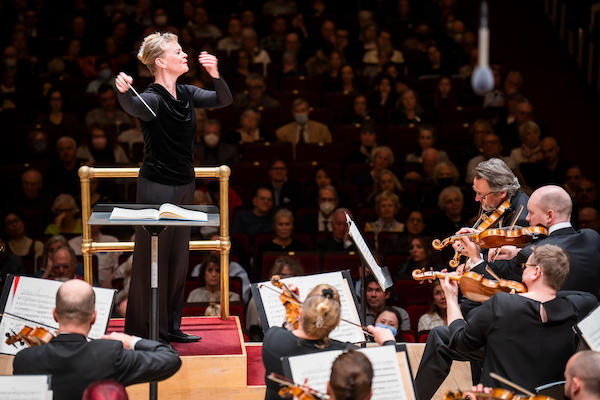Mälkki, Helsinki Philharmonic serve up a stirring night of Finnish music at Carnegie

New York audiences have gotten to know conductor Susanna Mälkki’s exceptional musicianship through her appearances as a guest with a number of orchestras. One of her consistent strengths with differing groups—including the New York Philharmonic and at the Met—has been her command of ensemble sound.
Tuesday night at Carnegie Hall, the audience got an even deeper and more powerful experience from Mälkki, as she led her own ensemble, the Helsinki Philharmonic Orchestra, in stirring playing that provided the finest orchestral concert of this season.
The program was an excellent set of Finnish music, with the central pieces Kaija Saariaho’s Aile du songe, with flutist Claire Chase the soloist, and Sibelius’ Symphony No.. 2.
This was an aesthetically and emotionally sensational evening, as well as bittersweet one. This is a farewell tour for Mälkki, who is leaving the orchestra at the end of this season. Her departing gift was the great musical heritage of her homeland, which one will likely encounter again, and tremendous orchestral playing at a level of musicality one hopes to hear again.
The concert opened with “Lemminkäinen’s return” from the larger Lemminkäinen Suite by Sibelius. The narrative of the hero returning from the dead, triumphant, was captured in sheer sound. From the first moments, one was thrilled by the purposeful technique of the orchestra, which was a powerful, precise, sleek mix of wood and metal. The ensemble created a floating bed of sound, and cruised along it, like a sailboat at the perfect angle to catch the wind.
One of those details included what seemed like the softest possible piccolo sound, appearing like a pinpoint of light against the churning low strings. Hearing this seemed an impossibility, but it was the kind of command of detail within the larger picture that Mälkki and the orchestra consistently delivered.
Most striking throughout the evening was the consonance and color. The orchestra played with a wonderful sense of everything coming together in the intonation and fullness—no matter the dynamics—of chords. There was the sensation of perfect pace and musical logic of each forward step.
That was natural in Sibelius’ narratives and also Saariaho’s flute concerto, which was heard in its Carnegie premiere. Based on the poetry of Saint-John Perse, Aile du songe balanced Chase’s shining flute sound against refined orchestral detail. Saariaho’s writing is exceptional, the flute playing long series of fragmented and abstracted bird song, while the orchestral response supports and stitches everything together into a long line.

Chase was superb, her playing dynamic and full of expression. In the second of the two sections, “Terrestre,” the score has the flutist morphing the instrumental lines into vocalizations and back again, a lovely effect that she played with complete ease and commitment. The orchestra was not so much behind her as next to her, playing with the call-and-response spirit and structure in the music, agile, active, and expressive.
The light-footedness of that showed one quality of the orchestra, and the massive, roiling, grand dimensions of the symphony showed many more. Along with their instrumental skill, one heard a sense of form and of the meaning in Sibelius’ thinking that was both profound and gorgeous in sonority.
Tempos, pace, and dynamics all felt ideal. Mälkki’s allegro in the finale was faster than one had heard yet came off as exactly right. But below this was something more powerful, which was an expression of Sibelius’ sense of pulse that seemed as massive as a forest and as weightless as the wind.
The extreme, rich tension between the bass line in the second movement, and the languid bassoon theme which seemed set in an entirely different tempo, was the most prominent example. Mälkki’s confident shaping of the pulse held this together and opened up Sibelius’ infinite internal landscapes.
This was profoundly affecting, opening up all sorts of inchoate responses. This was more than the satisfaction of hearing great playing of beautiful music—it was an exceptional and rare experience of feeling changed by something, of understanding oneself and the world around a little bit better. The sophistication of Sibelius’ composing, and of the musicians, was directly in touch with the basic human quality of making music.
There was no way after this that the orchestra could leave without an encore; they played two. The first was an abbreviated Valse Triste that was often extraordinarily quiet and also poignant and emotionally complex. Called out again after this, Mälkki told the audience that she and the orchestra would like be “slightly patriotic,” and launched into a poised, rugged Finlandia. The memory will last for a long time to come.
Claire Chase brings her Density 2036 project to Zankel Hall, 7:30 p.m. May 18.
The Met Orchestra plays Brahms’ Ein deutsches Requiem June 15, 8 p.m. carnegiehall.org



Posted May 10, 2023 at 2:17 pm by John F Kelly
Excellent review; though I would not be willing to call it the best concert of the season, it certainly was among them.
Hearing Sibelius from the Finns is like hearing the Czechs play Dvorak or Janacek. Looking at the names on the roster almost everyone seemed to have a Finnish or Scandinavian name. This music is absolutely in their musical bones.
I was initially worried at Malkki’s slow start to the second movement (which can be an awful drag if done too slowly) but she speeded up to what I would call a “normal” tempo after a while. There were some curious dynamic interventions in unexpected places of the Maazel-like variety but they all were convincing at the moment.
Ultimately a very convincing and powerful reading of the Sibelius Second.